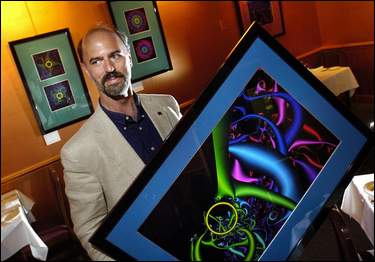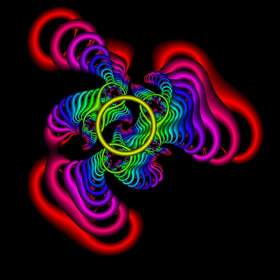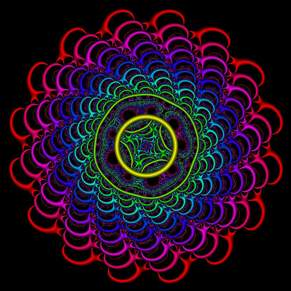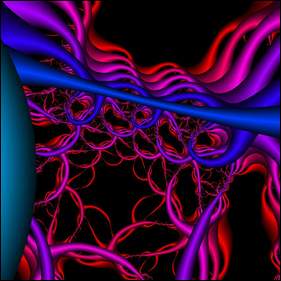• Shreveporttimes.com
• Weather
• Calendar
• Jobs
• Cars
• Real Estate
• Apartments
• Shopping
• Classifieds
• Dating

Article Search:
News
Local & State
Bossier News
Crime
Obituaries and Deaths
Education
Photo Galleries
Editorial
Business
Religion
Weather
Corrections
Nation/World
Mathematician colors his numbers into artworks
June 14, 2006

Dr. Paul Sisson, dean of Sciences and a professor of Mathematics at LSU-Shreveport, shows off his mathematical artwork "i Ching" that is on display at Bistro 6301 in Shreveport. (Jim Hudelson/The Times)
WANT TO OWN ONE?
Nine artworks by Paul Sisson hang on the walls of the piano room in Bistro 6301, 6301 Line Ave. in Shreveport.
The works are on sale and range from $400 to $700. Half the proceeds from sales will benefit the College of Sciences at LSUS.
Nine artworks by Paul Sisson hang on the walls of the piano room in Bistro 6301, 6301 Line Ave. in Shreveport.
The works are on sale and range from $400 to $700. Half the proceeds from sales will benefit the College of Sciences at LSUS.

"i of the Storm" (Jim Hudelson/The Times)

"half of Evolution" (Jim Hudelson/The Times)

"i of Medusa" (Jim Hudelson/The Times)

"i Belong to U" (Jim Hudelson/The Times)
Related news from the Web
Latest headlines by topic:
• Science / Technology
• Programming Languages
Powered by Topix.net
jenniferflowers@gannett.com
Paul Sisson goes where many cannot tread.
The complex landscapes he sees could take years to explain, and he rarely knows how to illustrate them.
"I'm just trying to get people to realize that math is beautiful," Sisson said. "It's not just the boring number crunching you did in high school."
Bistro 6301 co-owner Amy Grosz never scouted artwork for her restaurant at a mathematician's office before, but admits she was fascinated by Sisson's digitally printed images, especially when Sisson explained the concepts behind them. "Just the basis behind it is very interesting," she said. "I thought that the colors are really brilliant in the pictures. They way they contrast just within one little area, they seem to glow. It's really amazing that he can do that just by assigning a color to a number, basically."
Even without the theory, patrons have noticed the vibrant works, which are adding energy to the dining room, Grosz added. Many are more intrigued when they discover a mathematician made them.
Sisson wrote the program he uses for his artwork more than a decade ago in a programming language called Mathematica, employed by mathematicians and scientists to study, analyze and visualize concepts and data. His intent was to research complex numbers, or a collection of numbers that extends past the numbers familiar to the average Joe. But soon he fell in love with the resulting patterns and began manipulating their aesthetic attributes.
"In the simplest terms, it takes one complex number and turns it into another complex number," Sisson said.
His images are anchored by one central mathematical reference point, which usually appears as a gold ring. That ring's mathematical qualities become the reference point for the other spatial relationships and patterns. Green in his work represents one iteration of the original pattern, while blue represents two. Red represents 12 iterations, but that's as far as he goes -- anything higher is blanketed in black.
Sisson estimates his technique is 50 percent math and 50 percent art. "There's a lot of classic math here," he said. "But I also make up a function and look at it and see if I like it. If I don't like it, I try to modify it, and that's where the art comes in."
Sisson is no stranger to visual art. As a teenager, he made stained-glass lamps and custom windows in Michigan and almost moved to Chicago to make a career out of it before studying math. Two summers ago, he rode his motorcycle all the way to Corning, N.Y., to take glass-blowing classes.
Like Sisson, LSUS math professor Rick Mabry often is surprised at the beautiful images he sees when visualizing math and uses what he finds as examples in class. "It's like sculpting," said Mabry, describing Sisson's process. "He found the raw image and massaged it and tweaked it and explored it, really. "» He made some of those decisions based on some reaction to it."
Even with his doctoral degree, Mabry needed Sisson to explain the mathematical process behind his work, especially since he added his own aesthetic choices. "Artists tell me the discovery part is the art of the process," he said. "I used to think picking the right color was part of it, and artists are quick to tell me that's not what art is. "» The imagining and the trials and so forth, that's the art part."
Though math and art tend not to be uttered in the same breath, mathematicians and artists say they are deeply intertwined. Cubist Pablo Picasso, explained Sisson, used mathematical ideas by simultaneously representing multiple visual perspectives, or multiple points in time. Abstract expressionist Jackson Pollock left his work up to the randomness of his paint splatterings, but his process can be explained mathematically through chaos theory. Techniques like perspective and vanishing point all rely on basic mathematical principles.
And then there are Mandelbrot sets, mathematical patterns discovered by Benoit Mandelbrot, which have been discussed extensively in the art world. They inspire fractal art, in which self-similar images are repeated numerous times while getting smaller and smaller, making irregular shapes and patterns that cannot be explained with classical geometry.
And mathematicians are creating original art every time they break new ground in the field, according to Sisson. It's just not so easy to hang on the wall.
"I hope that people look at my artwork and ask, 'what is that?'" Sisson said. "Every time they do that, I have five minutes to talk about math."
Special Offer: For just $1 a week get The Times Sunday paper delivered to your home for the next 26 weeks! Click here to start your subscription.
©The Times
June 14, 2006
 Printer-friendly version
Printer-friendly version
Living Headlines
• Mathematician colors his numbers into artworks• The ponytail is back in style
• Plan your weekend: Let the Good Times Roll to offer great music
• Bullock and Reeves together again for 'Lake House'





